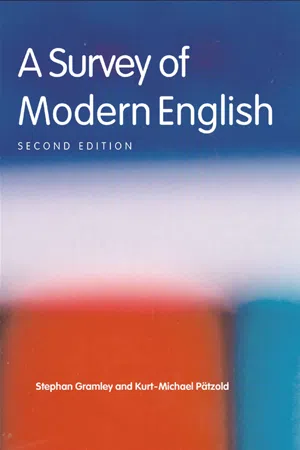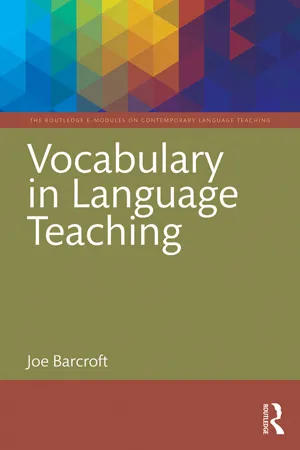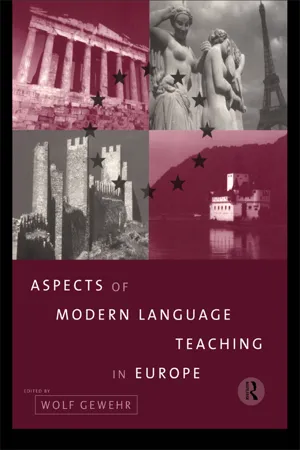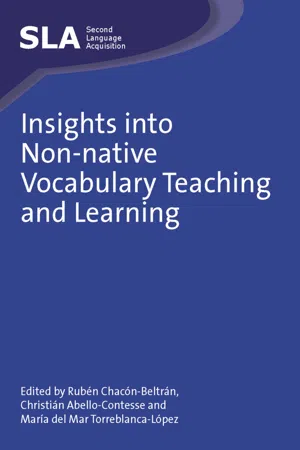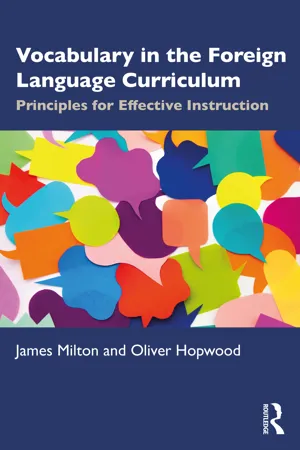Languages & Linguistics
English Vocabulary
English vocabulary refers to the collection of words and phrases used in the English language. It encompasses a wide range of words, from common everyday terms to specialized jargon. Building a strong English vocabulary is essential for effective communication, reading comprehension, and language proficiency.
Written by Perlego with AI-assistance
7 Key excerpts on "English Vocabulary"
Learn about this page
Index pages curate the most relevant extracts from our library of academic textbooks. They’ve been created using an in-house natural language model (NLM), each adding context and meaning to key research topics.
- eBook - ePub
- Stephan E Gramley, Michael Pátzold(Authors)
- 2004(Publication Date)
- Routledge(Publisher)
Part 1English as a linguistic system
Passage contains an image
Chapter 2Vocabulary
In this and the next chapter the words of the modern English language will be at the centre of our discussion. Chapter 3 will focus on combinations of words (so-called multiword units like idioms and proverbs). In this chapter the English Vocabulary will be looked at from various points of view: the concept of word and the relationship between words and meaning; the major types of dictionaries; the structure and development of the English Vocabulary; new words in the media and the Internet; euphemisms; non-sexist language; word formation; how words change their meanings; and a model commonly useful in the analysis of the English Vocabulary.2.1 WORDS AND MEANING
The vocabulary of the English language is conveniently recorded in dictionaries, of which the second edition of the Oxford English Dictionary (1989; abbreviated as OED2 in the following) is the most recent and comprehensive. Although many people think it the greatest dictionary in the world, reviewers have no difficulty in pointing to words and phrases that are missing. Linguists draw a distinction between dictionaries, which are only incomplete recordings of the English Vocabulary, and its total word stock, which they refer to as its lexis or lexicon.It is not only because new words are coined all the time that it is impossible to say precisely how many words there are in English. It is also because of the vagueness of the everyday term word. For example, how often is the word dictionary used in the preceding paragraph? Dictionary (with a capital D) and dictionary are each found once while there are two examples of dictionaries. If we say that there are three different words (Dictionary, dictionary, dictionaries) we are simply referring to the physical shape of words, in this instance the black marks that appear on the paper of this book. Linguists have coined the term word form for this use of word (word forms are conventionally quoted in italics). From a different point of view we might say that there are two examples of dictionary, one in the singular and the other in the plural. Linguists use word to refer to this second, grammatical, use (no special conventions). If we say, finally, that there are four occurrences of the single word dictionary we are basing our answer on the fact that, though different words and word forms are involved, they all show the same meaning. Word forms seen from the meaning point of view are called lexemes or lexical items (and are given in small caps). As lexemes can have many meanings, the need has been felt for a term which refers to the combination of one meaning with one word form. This is called a lexical unit. The lexeme old for instance represents at least two different lexical units. This becomes clear when you think of the opposite of old: one antonym is young, but old in my old boyfriend contrasts with new rather than young. What we find as main entries in dictionaries are lexemes, while each of the various meanings listed in these entries are lexical units. Having said all this, we will generally use the everyday term word - eBook - ePub
Corpus Linguistics for Vocabulary
A Guide for Research
- Paweł Szudarski(Author)
- 2017(Publication Date)
- Routledge(Publisher)
At this point, it is vital to describe research which explores the amount of vocabulary known by L1 and L2 users. When it comes to the vocabulary size of educated native speakers, one of the most oft-cited figures is about 20,000 word families or 32,000 vocabulary items, excluding proper names (Goulden et al. 1990). Referring to this issue, Schmitt (2010) states that a range of 16–20,000 word families seems to be a fair estimate, even though the figure is likely to vary depending on the quality and amount of language use by individual speakers. Without a doubt, this is a very high number, and it would be unrealistic to expect non-native speakers to reach the same level considering they have much more limited exposure to authentic language input. Consequently, as far as the estimates of non-native speakers’ vocabulary size are concerned, they tend to be lower and amount to around 8–9,000 word families. This is roughly half of what is expected of native speakers and results from research into the amount of vocabulary needed to perform different activities in a second (L2) language. In Nation’s (2006) seminal study which was already mentioned, it was found that 8–9,000 word families (written language) and 6–7,000 word families (spoken language) provide enough lexical coverage to ensure a good understanding of L2 texts. Thus, these figures are often given as a reasonable goal for L2 learning (Schmitt 2010; Siyanova-Chanturia and Webb 2016).To conclude, this section has highlighted the importance of vocabulary as a factor that influences general proficiency and constitutes a key element of becoming a mature language user. On the basis of the reviewed research, it can be stated that vocabulary plays a central role in general language performance; therefore, understanding how it is learned and used by individual speakers and writers is of paramount importance to the field of applied linguistics as a whole.p.36 3.2 Terminology‘Words’, ‘vocabulary’ and ‘lexis’ are examples of terms that are commonly used in the literature. A word can be defined as any sequence of letters bounded on either side by a space or punctuation mark (Carter 2004: 35), while ‘vocabulary’ and ‘lexis’ are terms that are often used interchangeably and subsume all lexical elements found in language. However, the term ‘lexis’ is probably more specific as it encompasses not only individual words but also different kinds of combinations between words (Scrivener 2005). Another alternative term is ‘lexicon’ which is understood as a collection of all words in a given language (Cheng 2012). A related notion is ‘mental lexicon’ which comes from psycholinguistics and refers to a ‘private’ dictionary of all the words stored in one’s memory (see section 3.3.3 for more details).When it comes to the terminology of corpus linguistics, once you engage in corpus analyses of vocabulary, you quickly realize that words occur in different forms and therefore the term ‘word form’ is often used to refer to different realizations of one ‘lexeme’. According to Carter (2004: 38), a lexeme is an abstract unit which underlies different grammatical variants of a word. For example, the lexeme ‘break’ can be realized by different word forms such as ‘broke’, ‘broken’ and ‘breaking’, and such variation is captured by the term ‘lemma - eBook - ePub
- Joe Barcroft(Author)
- 2015(Publication Date)
- Routledge(Publisher)
I’ll hope for you ), can lead to greater breakdown in communication, however. This alternative sentence is completely grammatical but is likely to require additional interaction (and negotiation of meaning) if its intended meaning is to be understood.Given this general state of affairs as a backdrop, the present module addresses key issues related to vocabulary in language teaching. The module is divided into three main sections. The first section discusses the nature of vocabulary knowledge and the mental lexicon. The second section focuses on how we learn vocabulary, including different contexts of vocabulary learning and the effects of different tasks and ways of presenting target vocabulary in the input. Finally, the third section highlights key implications for contemporary language instruction, taking into account ten principles of effective vocabulary instruction and providing a sample lesson.Vocabulary and the Mental Lexicon: A Network of Knowledge
The vocabulary or lexicon of an individual refers to all of the words, word parts (e.g., prefixes, suffixes), and lexical phrases (e.g., fixed strings of words such as The thing of it is …) that she or he has acquired at any given point in time. It exists as a vast network in the individual’s mind/brain. Within the network, every lexical item (word, word part, or lexical phrase) is connected to other lexical items in a manner that reflects statistical properties that dictate how lexical items should and should not be used. One example of these statistical properties is our capacity for collocation , which refers to how individual words and groups of words tend to appear next to one another (or co-occur) in a given language. In English, for example, we say save time but do not say *store time, and make the bed but not *do the bed or *set the bed . Our ability to know which words co-occur in this manner is based on extensive exposure to language over long periods of time. It comes from being exposed to and processing these same patterns of word co-occurrence (and lack thereof) in the input —samples of target language to which we are exposed—over hours, days, weeks, and years. Furthermore, for fluent language users, knowledge of collocation is implicit, meaning that it lies outside of a speaker’s conscious awareness. Fluent speakers of English do not consciously think about saying save time (instead of *store time or otherwise); they simply say it, based on previously acquired knowledge that is implicit and unconscious in nature. Similarly, if fluent speakers of English hear the phrase *store time - eBook - ePub
European Vernacular Literacy
A Sociolinguistic and Historical Introduction
- Joshua A. Fishman(Author)
- 2010(Publication Date)
- Multilingual Matters(Publisher)
Chapter 2 What is a ‘Language’ of Vernacular Literacy?Many crucial terms used in the social sciences are also used in everyday speech. The only problem is that in everyday usage terms are rarely precisely defined in advance. As a result, many a conversation that has gone on for hours may grind to a halt because one participant or another exclaims ‘But that is not what I mean when I say “freedom” (or “democracy”, or “peace”, or whatever)!’ In order for us not to be faced by any such problem after many pages, or even chapters, of our discussion, let us start by immediately defining the terms ‘language’. Does ‘slang’ qualify to be called a language? Does ‘Southern English’, like the kind that is spoken informally by many native residents of rural Mississippi, qualify? Does the native speech of recent Japanese immigrants from Okinawa, or that of newcomers to the US mainland from the coffee plantations near the southern coast of Puerto Rico or does the Spanish from ‘South of the border, down Mexico way’, qualify, because ‘almost everyone’s parents were native-speakers of either Spanish or one or another Amerindian language, all of which arrived here even before English did’? Does a spoken variety qualify even if it has no written counterpart at all, or even if it has no writing system? It would be good to get some of these questions clarified from the very beginning (not that full agreement may necessarily be reached even after ample discussion), so that we can all at least know if we are ‘on the same page’, even if we are not all on the same line of that page.A Dictionary Definition
A commonly used unabridged dictionary suggests a typical beginning definition of language as: ‘the way human beings communicate using words, whether written or spoken. It is also used for the particular system of communication used by a specific country, nation or community’ (Encarta, 1999: 1013). This particular dictionary then goes on to explain that ‘language’ is not the only way that individuals communicate and that it includes such subsidiary varieties as idiolects, dialects, slang, jargon, parlance, lingo, etc. The above overall definition could easily be ‘filled out’ by mentioning various further varieties of language, for example, occupational varieties, levels of formality in language, levels of seriousness in language, use of metaphor in language, related and unrelated languages, child language, animal languages, disturbed language, international and classical languages and so on. Gradually, what we originally took to be a simple, popular term, with a common meaning easily available to one and all, manifests itself to be full of unexpected complexities related to its widely differentiated users and uses. Obviously, only a modicum of reflection has revealed that there is nothing at all inherently simple about words such as ‘language’ and ‘languages’, since they reflect and convey all of the motivational and behavioral differences of the species that employ them, both to reveal and to disguise their goals, values and characteristics. - eBook - ePub
- Wolf Gewehr(Author)
- 2002(Publication Date)
- Routledge(Publisher)
This way of organizing words and their meanings for use in the FL classroom can help teachers to present vocabulary in such a way that students understand its meaning better. To this end, the vocabulary items to be taught must be carefully selected. Rather than using frequency as a criterion for selection, we have chosen the words within each area of meaning which best highlight the different lexical relations. This is the result of findings in psycholinguistic research on first and second language acquisition, and more concretely on the way people store information in their memory (Aitchison, 1987; Levin and Pinker, 1991).Such research can be of great use to FL teachers and can enable them to be more creative in classroom procedures. On the one hand, vocabulary exercises based on lexical structure are a vast improvement over long lists of miscellaneous vocabulary items, and, on the other, vocabulary presented in such a way enhances its memorability.The organization of vocabulary
It is generally agreed that words are not stored in our minds in a random way. Psycholinguistic experiments of association and retrieval show that our mental lexicon is organized in terms of meaning relationships. In other words, our mental dictionaries are organized more along the lines of a thesaurus than a traditional alphabetical dictionary.We1 have organized vocabulary in lexical fields based on definitional similarity. A lexical field is thus defined as the set of words whose definitions all have the same nuclear term. The inventory of the lexical units belonging to each field was determined by consulting both German dictionaries (Duden and Wahrig) and Spanish dictionaries (MaríaMoliner and M.Alvar) and analysing the definitions in both languages.Once the basic semantic information in each definition was established, encyclopaedicinformation was also inserted, as can been seen in the example of the paradigm of the verbs of eating in German and Spanish given in Table 12.2 .This paradigm also includes the different contexts in which these words can appear, as is evident in the underlined parts of each definition. These contexts are of two main types: intralinguistic(e.g. Fachsprache, salopp, lokal) and extralinguistic(e.g. in angenehmerAtmosphäre;oft imGaststättengewerbe, wo das Essenund Trinkenbezahltwird;guteQualität, gemütlicheAtmosphäre - Rubén Chacón-Beltrán, Christian Abello-Contesse, María del Mar Torreblanca-López, Rubén Chacón-Beltrán, Christian Abello-Contesse, María del Mar Torreblanca-López(Authors)
- 2010(Publication Date)
- Multilingual Matters(Publisher)
Vocabulary has always been an essential component of language teaching, and after a long period of relative neglect, it is now widely recognized as such. This has partly been due to a period of sustained attention and research which picked up momentum in the early 1990s. From this time, a number of influential books focusing on vocabulary were published (Bogaards & Laufer, 2004; Coady & Huckin, 1997; Folse, 2004; Nation, 1990, 2001; Schmitt, 2000; Schmitt & McCarthy, 1997). At the same time, research articles focusing on vocabulary issues appeared with regularity. One result of this research is that there is much more information concerning how to set up a principled approach to teaching vocabulary than before this vocabulary goldrush.Key Issues
This resurgent research has raised many issues, which can inform vocabulary teaching, and this chapter will concentrate on six in particular:- A large vocabulary is needed to function in an L2.
- Various kinds of word knowledge are needed to use a word well.
- Vocabulary learning is incremental.
- Vocabulary learning requires consolidation.
- Vocabulary learning requires enhancement of partial knowledge.
- Teaching vocabulary.
This chapter discusses each of these issues in turn, and attempts to demonstrate how they can inform a more coherent and principled approach to the teaching of second language vocabulary. The majority of vocabulary research has been on English as a second language (ESL), and thus the chapter normally uses English as the target language in the discussions. However, many or most of the points made will also be pertinent to the teaching of other modern languages.A Large Vocabulary is Needed to Function in a Language
In order to understand the best way to help learners acquire vocabulary, one must first know the extent of the vocabulary learning task. This involves knowing how many words need to be learned. There are a number of ways of looking at the amount of vocabulary which learners need to acquire. One way is to consider the vocabulary size of native speakers, who presumably have an adequate vocabulary size to use a language. In English, educated speakers (e.g. university students) appear to have a vocabulary size in the range of 15,000–20,000 word families (Goulden et al.- eBook - ePub
Vocabulary in the Foreign Language Curriculum
Principles for Effective Instruction
- James Milton, Oliver Hopwood(Authors)
- 2022(Publication Date)
- Routledge(Publisher)
Long and Richards (2007 , p. xii) writeVocabulary can be viewed as the core component of all the language skills.Laufer (2005) quotes one of the founders of modern linguistics, Henry Sweet, sayingThe greatest problem which a learner faces in learning a foreign language is to master the huge volume of vocabulary necessary for communication.Laufer herself reflects (Laufer and Sim 1985 , p. 410)Vocabulary knowledge is the most important area of knowledge required for comprehension.The idea that vocabulary is so important it should feature prominently in the curriculum, is not new either. Milton (2009 , p. 251) writesClear, and large scale, vocabulary goals should be a principal feature of any good teaching syllabus.Alderson (2005 , p. 88), goes as far as to suggest that the whole of language ability in a foreign language might be defined by vocabulary knowledge.Language ability can be largely described as a function of vocabulary size.You cannot learn a foreign language for communication without learning words, and lots and lots of them. That is a major challenge to any learner, and the task of the teacher and the curriculum is to help organise this process best.Coverage
What is it that makes vocabulary so important to comprehension of text and to foreign language ability generally? Coverage gives a really good idea of why this is the case. Coverage is the number of words, or more usually the percentage of words, a reader knows in any given text, and this number connects to the comprehension, generally speaking, that the reader can take from the text. If a learner is presented with a text where none of the words is known, then there will be no comprehension. No meaning can be taken from the text. However, if the learner knows all the words, then it is likely that there will be at least some comprehension, possibly full comprehension. Full comprehension may also require a knowledge of other elements of language such as structure and idiom. This is why school pupils may struggle with comprehension tasks in L1, even if they know all the words in the text in front of them. If a learner knows just some of the words in a text, then there is likely to be partial comprehension. The basic relationship is obvious here. The more words a learner knows in any text then the better comprehension is likely to be. Obvious, too, will be the inference that if a learner has a large vocabulary and knows a lot of words, they are likely to understand more words in a text and have better comprehension than a learner with a smaller vocabulary. There are complications in this relationship, but the principle is a good one to remember. The bigger a learner’s vocabulary is then the better their comprehension and communication is likely to be. An absolute essential of really good and fluent communication is a large vocabulary.
